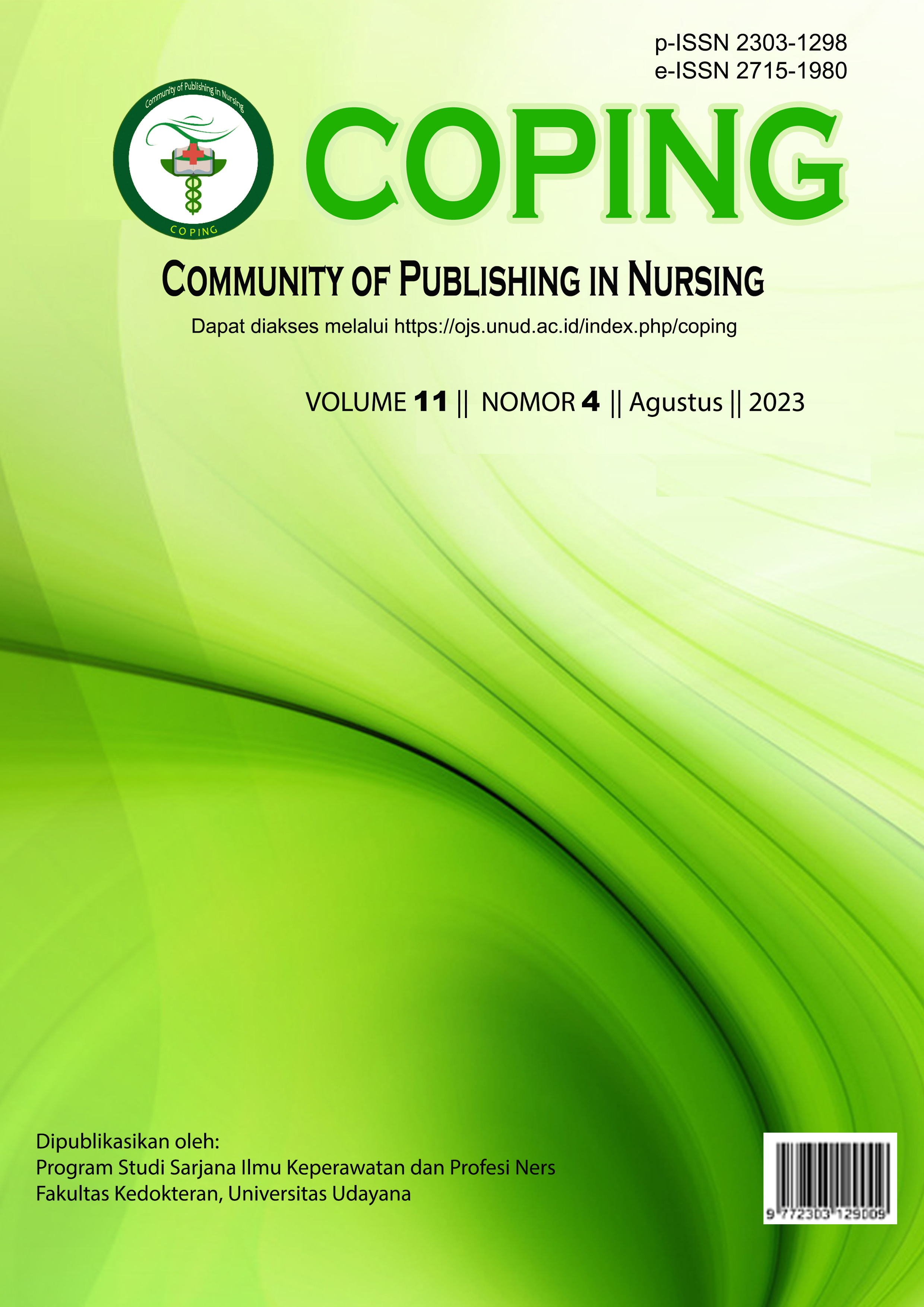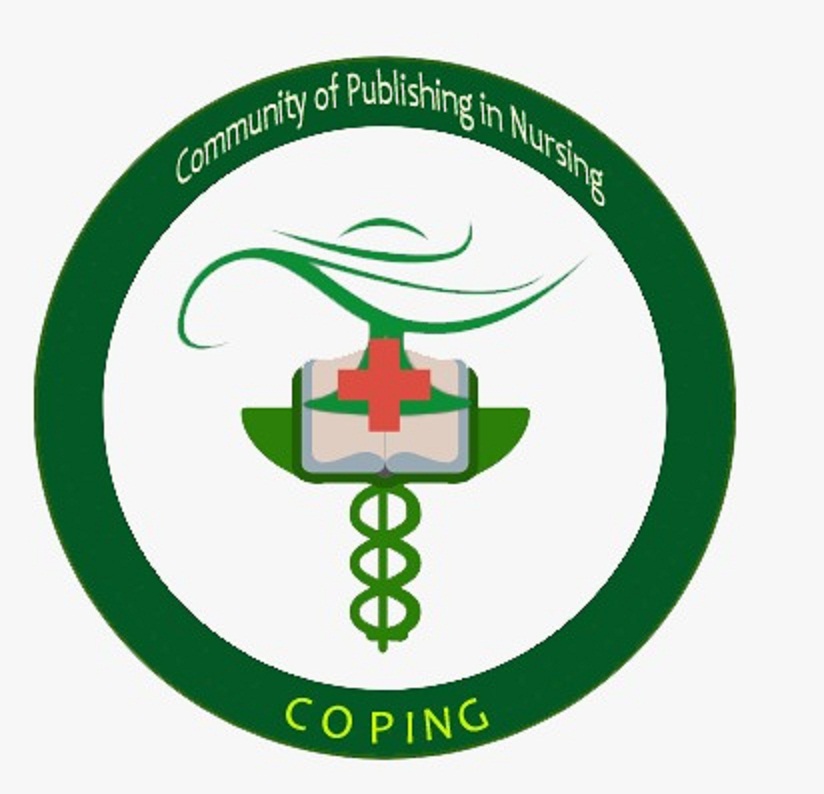WAKTU PULIH PASCAHEMODIALISIS
Abstract
Waktu pulih pascahemodialisis merupakan salah satu parameter penting yang dapat digunakan untuk memprediksikan kualitas hidup pasien hemodialisis. Meskipun waktu pulih sering dikaitkan dengan risiko rawat inap dan mortalitas, konsep waktu pulih belum diketahui secara jelas. Studi ini bertujuan untuk menyediakan sebuah state of the science mengenai waktu pulih pascahemodialisis. Desain yang digunakan adalah systematic literature review yang pencarian literaturnya dilakukan melalui beberapa database seperti PubMed, Science Direct, ProQuest, dan CINAHL. Sebanyak 11 artikel yang memenuhi kriteria digunakan dalam studi ini. Hasil analisis menunjukkan rata-rata waktu pulih pascahemodialisis berada pada rentang 2-6 jam. Usia tua, jenis kelamin perempuan dan ras kulit hitam didapatkan lebih berisiko mengalami pemanjangan waktu pulih. Selain itu, pemanjangan waktu pulih juga lebih berisiko terjadi pada pasien dengan gangguan psikiatri seperti depresi, memiliki komorbid, indeks massa tubuh yang berlebih, mengalami penurunan napsu makan, dan mengalami komplikasi hemodialisis. Faktor biokimia darah dan regimen hemodialisis juga ditemukan memiliki kaitan erat dengan waktu pulih. Terdapat beberapa faktor yang dapat memperpanjang waktu pulih pascahemodialisis. Waktu pulih dapat digunakan sebagai indikator subjektif yang menjelaskan kondisi pasien pasca menjalani satu sesi hemodialisis sehingga waktu pulih perlu dikaji secara rutin di ruang hemodialisis.
Downloads
References
Ali, M., Ejaz, A., Iram, H., Solangi, S. A., Junejo, A. M., & Solangi, S. A. (2021). Frequency of Intradialytic Complications in Patients of End-Stage Renal Disease on Maintenance Hemodialysis. Cureus, 13(1). https://doi.org/10.7759/CUREUS.12641
Alvarez, L., Brown, D., Hu, D., Chertow, G. M., Vassalotti, J. A., & Prichard, S. (2020). Intradialytic Symptoms and Recovery Time in Patients on Thrice-Weekly In-Center Hemodialysis: A Cross-sectional Online Survey. Kidney Medicine, 2(2), 125–130. https://doi.org/10.1016/J.XKME.2019.10.010
Antari, G. A. A., Sukmarini, L., & Adam, M. (2019). Associated factors of post-hemodialysis recovery time in kidney failure patients. Enfermería Clínica, 29, 247–251. https://doi.org/10.1016/J.ENFCLI.2019.04.139
Awuah, K. T., Afolalu, B. A., Hussein, U. T., Raducu, R. R., Bekui, A. M., & Finkelstein, F. O. (2013). Time to recovery after a hemodialysis session: impact of selected variables. Clinical Kidney Journal, 6(6), 595. https://doi.org/10.1093/CKJ/SFT120
Bikbov, B., Purcell, C. A., Levey, A. S., Smith, M., Abdoli, A., Abebe, M., … Murray, C. J. L. (2020). Global, regional, and national burden of chronic kidney disease, 1990–2017: a systematic analysis for the Global Burden of Disease Study 2017. The Lancet, 395(10225), 709–733. https://doi.org/10.1016/S0140-6736(20)30045-3
Bossola, M., Di Stasio, E., Monteburini, T., Parodi, E., Ippoliti, F., Cenerelli, S., … Laudisio, A. (2019). Recovery Time after Hemodialysis Is Inversely Associated with the Ultrafiltration Rate. Blood Purification, 47(1–3), 45–51. https://doi.org/10.1159/000492919
Bossola, Stasio, D., Antocicco, Silvestri, & Tazza. (2013). Variables associated with time of recovery after hemodialysis. Journal of Nephrology, 26(4), 787–792. https://doi.org/10.5301/JN.5000198
Bossola, & Tazza. (2013). Appetite is associated with the time of recovery after the dialytic session in patients on chronic hemodialysis. Nephron. Clinical Practice, 123(1–2), 129–133. https://doi.org/10.1159/000353219
Bossola, & Tazza. (2016). Postdialysis Fatigue: A Frequent and Debilitating Symptom. Seminars in Dialysis, 29(3), 222–227. https://doi.org/10.1111/SDI.12468
Centre for Disease Control and Prevention. (2023). Chronic Kidney Disease in the United States, 2023. Retrieved October 28, 2023, from https://www.cdc.gov/kidneydisease/publications-resources/ckd-national-facts.html
Chan, C. T., Blankestijn, P. J., Dember, L. M., Gallieni, M., Harris, D. C. H., Lok, C. E., … Zakharova, E. (2019). Dialysis initiation, modality choice, access, and prescription: conclusions from a Kidney Disease: Improving Global Outcomes (KDIGO) Controversies Conference. Kidney International, 96(1), 37–47. https://doi.org/10.1016/J.KINT.2019.01.017
Davenport, A., Guirguis, A., Almond, M., Day, C., Chilcot, J., Gane, M. D. S., … Farrington, K. (2018). Postdialysis recovery time is extended in patients with greater self-reported depression screening questionnaire scores. Hemodialysis International, 22(3), 369–376. https://doi.org/10.1111/HDI.12642
Gaipov, A., Issanov, A., Kadyrzhanuly, K., Galiyeva, D., Khvan, M., Aljofan, M., … Kovesdy, C. P. (2020). Epidemiology of dialysis-treated end-stage renal disease patients in Kazakhstan: data from nationwide large-scale registry 2014-2018. BMC Nephrology, 21(1). https://doi.org/10.1186/S12882-020-02047-6
Garg, A. X., Suri, R. S., Eggers, P., Finkelstein, F. O., Greene, T., Kimmel, P. L., … Chertow, G. M. (2017). Patients receiving frequent hemodialysis have better health-related quality of life compared to patients receiving conventional hemodialysis. https://doi.org/10.1016/j.kint.2016.10.033
Guedes, M., Pecoits-Filho, R., Leme, J. E. G., Jiao, Y., Raimann, J. G., Wang, Y., … Larkin, J. W. (2020). Impacts of dialysis adequacy and intradialytic hypotension on changes in dialysis recovery time. BMC Nephrology, 21(1), 1–10. https://doi.org/10.1186/S12882-020-02187-9/TABLES/4
Himmelfarb, J., Vanholder, R., Mehrotra, R., & Tonelli, M. (2020). The current and future landscape of dialysis. Nature Reviews. Nephrology, 16(10), 573–585. https://doi.org/10.1038/S41581-020-0315-4
Holley. (2006). A descriptive report of errors and adverse events in chronic hemodialysis units. Nephrology News & Issues, 20(12). Retrieved from https://pubmed.ncbi.nlm.nih.gov/17125098/
Hussein, W. F., Arramreddy, R., Sun, S. J., Reiterman, M., & Schiller, B. (2017). Higher Ultrafiltration Rate Is Associated with Longer Dialysis Recovery Time in Patients Undergoing Conventional Hemodialysis. American Journal of Nephrology, 46(1), 3–10. https://doi.org/10.1159/000476076
Jaber, B. L., Lee, Y., Collins, A. J., Hull, A. R., Kraus, M. A., McCarthy, J., … Finkelstein, F. O. (2010). Effect of Daily Hemodialysis on Depressive Symptoms and Postdialysis Recovery Time: Interim Report From the FREEDOM (Following Rehabilitation, Economics and Everyday-Dialysis Outcome Measurements) Study. American Journal of Kidney Diseases, 56(3), 531–539. https://doi.org/10.1053/J.AJKD.2010.04.019
Kazancioǧlu, R. (2013). Risk factors for chronic kidney disease: an update. Kidney International Supplements, 3(4), 368–371. https://doi.org/10.1038/KISUP.2013.79
Lin, Z.-H., & Zuo, L. (2015). When to initiate renal replacement therapy: The trend of dialysis initiation. World Journal of Nephrology, 4(5), 521. https://doi.org/10.5527/WJN.V4.I5.521
Lindsay, R. M., Heidenheim, P. A., Nesrallah, G., Garg, A. X., & Suri, R. (2006). Minutes to Recovery after a Hemodialysis Session: A Simple Health-Related Quality of Life Question That Is Reliable, Valid, and Sensitive to Change. Clinical Journal of the American Society of Nephrology, 1(5), 952–959. https://doi.org/10.2215/CJN.00040106
Lopes, Silva, Pinto, Catto, Martins, Dutra, & Lopes. (2014). Patient’s response to a simple question on recovery after hemodialysis session strongly associated with scores of comprehensive tools for quality of life and depression symptoms. Quality of Life Research : An International Journal of Quality of Life Aspects of Treatment, Care and Rehabilitation, 23(8), 2247–2256. https://doi.org/10.1007/S11136-014-0666-Z
Lv, J. C., & Zhang, L. X. (2019). Prevalence and disease burden of chronic kidney disease. Advances in Experimental Medicine and Biology, 1165, 3–15. https://doi.org/10.1007/978-981-13-8871-2_1
Moore, C., Carter, L. A., Mitra, S., Skevington, S., & Wearden, A. (2020). Quality of life improved for patients after starting dialysis but is impaired, initially, for their partners: A multi-centre, longitudinal study. BMC Nephrology, 21(1), 1–18. https://doi.org/10.1186/S12882-020-01819-4/FIGURES/10
Murray, A. M., Tupper, D. E., Knopman, D. S., Gilbertson, D. T., Pederson, S. L., Li, S., … Kane, R. L. (2006). Cognitive impairment in hemodialysis patients is common. Neurology, 67(2), 216–223. https://doi.org/10.1212/01.WNL.0000225182.15532.40
Raja, S. M., & Seyoum, Y. (2020). Intradialytic complications among patients on twice-weekly maintenance hemodialysis: an experience from a hemodialysis center in Eritrea. BMC Nephrology, 21(1). https://doi.org/10.1186/S12882-020-01806-9
Rayner, H. C., Zepel, L., Fuller, D. S., Morgenstern, H., Karaboyas, A., Culleton, B. F., … Robinson, B. M. (2014). Recovery Time, Quality of Life, and Mortality in Hemodialysis Patients: The Dialysis Outcomes and Practice Patterns Study (DOPPS). American Journal of Kidney Diseases : The Official Journal of the National Kidney Foundation, 64(1), 86. https://doi.org/10.1053/J.AJKD.2014.01.014
Selcuk, A. A. (2019). A Guide for Systematic Reviews: PRISMA. Turkish Archives of Otorhinolaryngology, 57(1), 57–58. https://doi.org/10.5152/TAO.2019.4058
Smokovska, N., Grozdanovski, R., & Spasovski, G. (2015). Impact of different variables on recovery time in patients receiving hemodialysis. BANTAO Journal, 13(1), 20–24. https://doi.org/10.1515/BJ-2015-0005
Tuttle, K. R., Alicic, R. Z., Duru, O. K., Jones, C. R., Daratha, K. B., Nicholas, S. B., … Norris, K. C. (2019). Clinical Characteristics of and Risk Factors for Chronic Kidney Disease Among Adults and Children: An Analysis of the CURE-CKD Registry. JAMA Network Open, 2(12), e1918169–e1918169. https://doi.org/10.1001/JAMANETWORKOPEN.2019.18169
USRDS. (2020). Annual Data Report | USRDS. Retrieved from https://adr.usrds.org/2020/end-stage-renal-disease/1-incidence-prevalence-patient-characteristics-and-treatment-modalities
Yoowannakul, S., Tangvoraphonkchai, K., & Davenport, A. (2019). Patient-reported intra-dialytic symptoms and post-dialysis recovery times are influenced by psychological distress rather than dialysis prescription. Renal Replacement Therapy, 5(14). https://doi.org/10.1186/s41100-019-0211-1
Zazzeroni, L., Pasquinelli, G., Nanni, E., Cremonini, V., & Rubbi, I. (2017). Comparison of Quality of Life in Patients Undergoing Hemodialysis and Peritoneal Dialysis: a Systematic Review and Meta-Analysis. Kidney & Blood Pressure Research, 42(4), 717–727. https://doi.org/10.1159/000484115

This work is licensed under a Creative Commons Attribution-NonCommercial 4.0 International License.







